How I Got to Mariposa |
|||
|
|
|||
 |
 |
||
| Mariposa 1859 (Carlton Watkins) | Postcard from the late 1940s | Mariposa 1950 (Roy Radanovich) | |
|
People's Stories |
|||
Introduction Browse Stories Carol Ballard Arriola Nancy Garrett Werner Dick Estel Gail Rowe McNally Family Dottie Smith Pingiczer Links |
|||
|
Introduction: In mid-2013 I asked people from Mariposa to submit a write-up on how they or their family came to be in Mariposa. It was sent to people on the MCHS alumni mailing list, and also posted on Facebook. If you're from Mariposa and haven't heard of it before, here is your assignment: You thought you were done with homework? No way! We are putting together web pages relating to recent Mariposa history (the part we lived through) and you are invited, in fact, encouraged, in fact, begged to participate. 1. How I Got to Mariposa (that's this page): The story of how you and your family first came to Mariposa County. If they were there long before you were born, go back as far as you can, with as much detail as you have available, but remember, even the Internet has limits. 2. Our Elementary Schools: This project is well under way, having been started in 2007 in connection with the class of 1957 50-year reunion (read it here). So far only four schools are represented, which is just a small part of the many country schools that once dotted the county. If the school you attended is already covered, feel free to add additional memories that we may have missed. Although this is intended to be primarily personal memories, if your parents told you good stories that you still remember about long-gone schools, send them along. Photos of the school or early classes are welcome. I'm not sure where this will end up, but at the least it will be part of the Alumni Association web site. Who knows? It could become a book and sell tens of copies! Yes, TENS, not TONS. One last assignment, which is for "extra credit." If you have not already done so, write down everything you remember and share it with your kids and grandkids and so on. Audio and video recordings are good too. Everyone who dies takes with them a lot of knowledge and memories that can't be recovered anywhere. Nearly every week I think of something I wish I had asked my parents about. How this will benefit you: Several years ago I wrote up the story of all the backpacking trips I had taken starting in the late 1970s, and covering events that had occurred between 32 and 10 years earlier. I found as I wrote that I remembered more and more details, the recording of it triggering additional memories. So as you write, you will be rewarded by some great memories you thought were forgotten. And it will be good for your brain! Text in parentheses and in italics below are notes and comments by the editor (me). Click on photos for a larger view; they will open in a new window. --Dick Estel, October 2013 |
|||
| Carol Ballard Arriola (Class
of 1953) (Most of the information here also applies to her late
brother, Jim)
My parents, Glenn and Helen, younger brother Jim, and I moved from San Fernando when I was ten. San Fernando was even more obscure than Bootjack in those days. We were surrounded by sweet potato and asparagus fields as far as the eye could see until the Japanese farmers were all taken away to concentration camps. We left in 1945 and returned a year later to discover tract houses in all directions. Bicycle paths made by Jim and me had names and were now paved roads! Daddy
begin work in old Los Angeles, wheeling wheelbarrows of cement for the City in 1925 at age twelve,
helping to support his mother and little sister. Grandma made very little
money playing the organ in silent movies. Daddy progressed to Park
Superintendent for Griffith
When
Harvey and Nola Bonnell moved to Mariposa, Daddy drove their moving truck.
I think he did odd jobs for them, not sure, but I know we knew them in
some working relationship. Mama rode along on the second load of pigs,
goats and chickens to Mariposa, drove through what became our ranch, which
Harvey
told them was for sale. Daddy asked Mama if she would "like it for
her birthday" and two weeks later we traded houses with those people:
Gone forever was the stash of war bonds for our someday ranch. It didn't
take long to learn that it was impossible to earn a living working the
ranch and Daddy went to work at Scott's Mill after getting up at Barb Butler (nee Young) lived down the street from Mama, maybe in third grade. They remained best friends forever. Barb was Mama's maid of honor at Mama and Daddy's wedding. Chuck and Barbara Butler and son Bobby came to Mariposa to visit us and like us, decided to move there. There was a lot of discussion about living together. They would build an extra room on our tiny 700 square foot house. I hated the idea for a variety of reasons, but instead of talking about it, all I did was cry when it was spoken of. I don't know why the togetherness plan didn't come about; nobody ever talked of it again and I had forgotten all about it until now. Can you just imagine seven people living in a little house like that? They must have all been nuts. I assume they all were very short of money in those days right after the war and thought that would help us all. In any event, Mariposa became our home for many years. My mother died young (in her 50s); Daddy remarried and spent his final years in the southern California desert. I ended up in the Santa Cruz area, while Jim spent the rest of his life in Mariposa, also passing away too soon. (Dad and Glenn worked together and in the same building for many years, and the Estel's and Ballard's visited back and forth and spent a lot of time together fishing at Lake McClure, picnicking and swimming on the river below Briceburg. Despite this, I have no photos of those times, though I wish I did.) |
|||
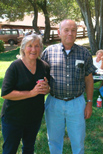 |
 |
||
| Carol
and Jim Ballard, June 17, 2000 |
Maybe a Fair Queen Contest photo | ||
|
In the early 1900s my grandfather, Frank Estel, became friends with the boy across the road, Roy Merrill, in rural Fulton County, Ohio. It was a friendship that would last throughout their lives. Time passed, a bunch of stuff happened, and in 1935 Frank, his wife Mabel, and son Bob decided to seek the gold of California. Not nuggets of the real stuff, but the silver and copper of a job in those hard times. Frank had cousins in Pasadena, and in the winter of 1934-35, they set out for the west. Of course, it would be more romantic if they had traveled on Route 66, but
that highway ran through some high altitudes and latitudes, and the
possibility of snow was great, so they took the more southern route of Grandma’s diary for January 3 contains a simple one-line entry: “Arrived in Pasadena 1:30 at Fred’s.” They played the part of tourists, going to the ocean, seeing the southern California sights, going to the movies, and enjoying warm sunshine at a time of year when they had normally experienced the snow and below freezing weather of northwest Ohio. Frank and Bob also worked at whatever odd jobs they could find, such
things as delivering handbills. Grandma’s diary for March 5 notes that
they worked all day and made $3 each. Meanwhile, Roy, his wife Ruby, and sons Marion (Molly) and Deane had been in Mariposa since the mid 1920s, living on a ranch in Bootjack, at the junction of present-day Highway 49 South and Silva Road.
Feb 2:
Feb 5: Frank, Ruby and Bob went
to Merced
for parts for our Ford. Ruby and I went to her mother’s at Mariposa for
dinner. Home In April, the diary records a visit from They accepted this offer and left Pasadena
early on the morning of May 28, 1935, arriving at Roy’s place about Because of the elevation, work came to a halt during the winter, and the Estel’s returned to Ohio at least two of those first winters. In 1938 Bob returned with his new bride, the former Hazel Mason. Grandpa and Grandma ended up living in Ventura before moving to Fresno after his retirement. Bob and Hazel stayed in Mariposa the rest of their lives (2005 and 2007 respectively). I came along in August of 1939, just in time to attend the first Mariposa
County Fair. After living a short time in a cabin on the Merrill ranch,
Dad built a house where Pegleg Road
joins the present Highway 49. We spent some time in Ventura
in 1942-43, where my sister At some time in the early 1940s the Merrill’s moved to a place on Triangle Road, property that is still in the family and occupied by Molly's daughter Susan Merrill Crandall, and one of Marvin’s sons and his family. The rest is history that will be recorded elsewhere (Susan's house, built in the early 2000's, was destroyed in the Oak Fire in 2022. The other house, dating from the 1940s' survived. Dick retired from the Fresno County Department of Social Services in 2002 and lives in Clovis. Linda moved to Minnesota in her 20s, and lives with her wife Anne on 20 acres outside Duluth ). |
|||
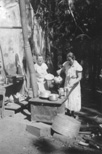 |
 |
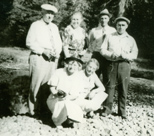 |
|
|
Ruby Merrill and Mabel Estel,
cooking |
Bob,
Mabel & Frank Estel at Coolidge Dam in Arizona, December 1936 |
Herb Unknown, Mabel & Frank Estel, Roy Merrill, Bess Unknown, Ruby Merrill, September 1937 | |
 |
 |
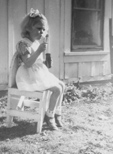 |
|
| Bob
& Hazel on the porch of their cabin at the Merrill Ranch, 1938 |
|
Linda Estel at Pegleg Road house in Bootjack, about 1947 | |
|
Gail Rowe (Class of 1955): (This is also the story of Gary Rowe, Gail's older brother) During
the Second World War my parents, Les and Alma Rowe, became very close to
the Ansel “ As the war drew to a close, the two families put their homes up for sale
and took several trips to find a small, mountain community in which to
begin a business and raise their families, visiting Sonora, Tuolumne, and
Sutter Creek, among other towns. Once they visited Mariposa, they agreed
that it had all they wanted in terms of business potential, despite the
fact that merchandise would have to be trucked up from Merced,
thirty-seven miles away. The
next step was finding a suitable location within Mariposa. They fortuitously ran into Lena Light at a local restaurant and she told them of a building owned by Roy and Alice Hampton, who also owned the Fremont Hotel. An agreement was quickly reached with the Hampton's to rent and remodel the building situated on the main street between Oscar Hagen’s Capitol Café and Bar and the Highway Patrol Office. Fortunately, both families were able to sell their homes and get the money needed for moving, renting the store, and remodeling it. My folks sold their home on the very last day before they left the Los Angeles area for Mariposa with all their worldly goods.
Mike
and Virginia Michael, their two children Ilene and Danny, my folks, my
brother Gary and I, and our dog Polly arrived in Mariposa on April 4,
1946. Both families moved into the unfinished basement of the store. My
father and I explored the town. The first new friends for Gary, me, Ilene, and Dan were the Tedrow children, Barbara, Cathy, and their younger siblings who lived across the creek from the store. In our first week or so in Mariposa, Gary and I also found our way to the softball field between the high school and elementary school and met Orville Rhoan, Wally Hufford, George Stoughton, John Tressider, Clifford Dulcich, and a few others engaged in a baseball game. We were encouraged to join in. In subsequent days this group was also joined by Leroy and David Radanovich and Lloyd Bradshaw. I knew I’d found a home. Gary and I were enrolled in the Mariposa Elementary School in the spring
of ’46 and soon found ourselves under the skillful guidance of such
teachers as Mrs. Fellows, Mrs. Ellingham, and Mrs. Clark. It was a
wonderful start to a life of - and in - education. (Gail graduated from Mariposa Elementary School, in June, 1951 and from Mariposa High in 1955. He went on to become a university history professor, spending most of his career at the University of Northern Colorado in Greeley. Gail passed away November 13, 2016. He is survived by his wife, the former Mary Jordan, also a member of the class of '55. Gary graduated in 1954 and married the former Ann Jaynes. They lived in the Bay Area until Gary passed away in 2021.) |
|||
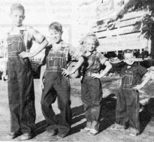 |
 |
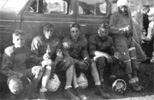 |
|
|
Gary and Gail Rowe, Ilene and Danny Michael |
The Western Auto Store, downtown Mariposa, late 1940s | An
elementary school football game at the high school field, 6th grader Gail Rowe on the left, probably 1949 (Click here for names) |
|
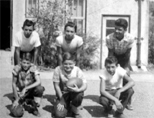 |
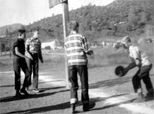 |
 |
|
|
The
"Blue Team" in front of the entrance, Gail |
Basketball
at the Elementary School: L-R: Ronnie Jones, Gary Rowe, G.M. Rainwater (?), and Ed Carey |
Mariposa
Elementary class on the steps, probably 1951; Gary Rowe second from right, middle row (Click here for names) |
|
|
McNally Family: (The following was written by Velma McNally Tarver, sister of Claude, Lindsey, Merrill, Esma (Poor), Irva (Jordan), Mary (Oakes), et al, who I knew. It was taken from the Mariposa History and Genealogy web site (click on Chronicles; then on Hart/McNally). As Mariposa natives know, the McNally family is connected to many other pioneer and later day families in the county. Our thanks to Velma for permission to use this. --DE) I
am a native of Mariposa and my family line goes back quite a few years.
David Hart was my great grandfather. He was born in 1825 in Jacksboro, David made several trips to
California
on horseback, the first time being about 1848. He originally mined along
the American
He settled at the top of Big Spring Hill and named their town Sebastopol
Flats, in honor of an uncle who died at Sebastopol, Russia
while fighting in the Crimean War. At one time there were as many as 14
buildings in the town. He donated the property and the building for the
first David and Nancy had fourteen children. The eldest was Mary Elizabeth, born
in Charles Clay was born in
Tennessee
in 1851 and died in Mariposa in 1915. My father, Henry McNally, used to
tell us children stories about Charlie, which we devoured with great
interest. He told us that my mother, Dora, was very afraid of Charlie, but
that he would not harm a hair on her head. He also told us that he (Henry)
befriended Charlie and when he spent time in prison for killing Susan, my grandmother was born in Tennessee in 1852 and died in 1929 at Seaside, California. She married David Christopher McNally in 1872 in Mariposa. He was born in Scotland. His family was from Ireland, but moved to Scotland during the potato famine and then migrated to Toronto, Canada. David and his brother Daniel came to California by ship around the horn. They left two sisters in Toronto. David and Susan made their home in the Red Mountain Area and later lived at Bootjack, which he named because the road forked right there and looked like a boot jack. David McNally mined and ranched, sometimes in partnership with his father-in-law. He developed the Silver Bar Mine, at that time the only silver mine in Mariposa County. Susan and David had six children: Nancy Kathryn born 9/17/1874, died
5/8/1935 in Fresno, married William Williams 9/11/1900 Bear Valley; Walter
David born 4/18/1875 Sebastopol, died 2/20/1957, married Alberta (Birdie)
Lewis (no relation to my mother); Margaret was born 1878, died 11/17/1934,
married Carl S. Gibbs 12/19/1904 in Bootjack. Henry John (my father) was
born Henry had a varied career of miner, carpenter, bar keeper (at my grandfather’s sawdust floor saloon at Bootjack). He was a school bus driver and for quite a few years was a fire lookout for U.S. Forest Service at Signal Peak Lookout Station. Minnie McNally was born Raymond was the youngest. He married Minnie Kenyon in San Jose in 1909. I
have the history of the Hart family from Thomas in England, and it includes many names important in the history of the
United States. They include Daniel Boone; Henry Clay, whose wife was Lucretia Hart,
early settlers in Boonsboro. Captain David Hart, (my --Velma McNally Tarver, MCHS class of 1942 (The original version of this narrative includes a great photo.) |
|||
|
Dottie Smith Pingiczer (Class of 1957): (While this doesn't quite fit any of the "assignments" above, it is worth preserving and captures a particular experience of coming to Mariposa) I just read the article about every one from the class of ‘57 going to small schools. I would like to share some of my thoughts. Just before I entered 9th grade, we arrived from the big city of Riverside to the small area of a ranch off Triangle Road. Imagine leaving the big city life to a life of no TV, no phone, a half mile from the Barrett turkey farm. A place where the only heat was from a wood stove – and you had to chop wood in the summer to keep warm in the winter! I now tease Beverly Van Gundy that she was “upper class” as they had
propane! My parents and the Raby family moved together from big city life
to county life. Those changes are now good memories –going to the old
school house with a bell that still worked. I remember box socials and hoping my boy friend would bid on mine. Such a different life style. The news from the town of Mariposa would travel faster than a telephone call even though we were twenty miles from Mariposa (although most had no phone). Every one knew or knew of every one. I remember when females could not wear jeans or long pants to school. I would walk a half mile on a dirt road to Triangle Road where Mr. Bevel would stop with the bus. My last year in high school my dad was the bus driver...and I was lucky to have his picture in the class year book. |
|||
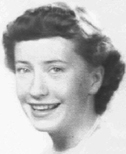 |
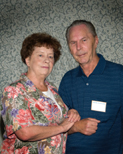 |
||
| Dottie in 1957 |
|
||
|
Nancy Garrett Werner: My first memory of Mariposa County was visiting my Grandfather William O. Garrett at his mining cabin in the summer of 1948. He and his brother George Garrett had a mining claim in the Merced River Canyon. He always harbored a love for gold and worked this claim throughout his life. He also harbored a love for pancakes and I’ve been told he had pancakes for breakfast nearly every morning. His cabin was between Bagby and Coulterville on the canyon side of Highway 49. In later years my father Norman William Garrett and his brother Donald Frederick Garrett worked another claim in the same area. The
I
will never forget my “big sister” Ethel Clark who lived behind the
store with her mother, Charlene, and her brothers Bill, Mike and Donald.
Her Grandfather lived in a cabin upriver at the old railroad turn around.
I learned to swim in that river and our family and friends spent many
happy times camping, swimming and fishing at that memorable location. In
later years, my Dad developed a trailer park aptly named Fly-A-Way
Park
along
the creek where he used to catch minnows. His wish was to have others
discover the gem of a place called Bagby on the Merced River. My
Grandparents had also lived for a time in a home near the Merced River in
a place called Hunter’s Valley. I believe this would have been in the
early forties. I’m pretty sure my Aunt Lucile and Uncle Robert Galbraith
lived in Bear
Valley
around
the same time. Interestingly
enough, my Dad told me a story about a family member named Frank Garrett
(Uncle George’s son) who is buried in Bear
Valley.
Apparently he was killed in a gunfight with a John Beck, in 1921. I have
found newspaper articles that indicate the killer went unpunished for
years but turned himself in, in 1945 in Oroville, California.
There was a trial in My
Father, Norman William Garrett was born in Jacksonville,
Oregon
on My
mother, LaRue Fipps Garrett, also had Mariposa roots. Her Aunt Eunice
Bauer Fipps was born in Hornitos in 1889. Her father was Michael Bauer and
her mother was Mary Jane Geary. Michael was the son of Aegidius Bauer who
emigrated from Germany
and
ranched on the north side of Hornitos. Mary Jane was the daughter of John
Geary whose family came from In
1973 my father remarried Alberta Rose Jeffery (Jeffery Hotel). She too,
has very deep Mariposa County
roots.
She worked at The Mariposa County Hall of Records for 28 years and became
County
Treasurer/Tax
Collector in 1971, retiring in 1978. She was born in Yosemite
I
moved to Mariposa in 1958. I attended Mariposa
Elementary
School
and
Mariposa |
|||
| Links - MCHS Alumni | |||
| Home Page | Class Activities & Contacts | Events | |
| Photo Gallery | MCHS Graduates | Updates & Changes to MCHS Pages | |
| Visit us on Facebook | Our Elementary Schools | Alma Mater & Fight Song | |
| Other Links | |||
| Mariposa County History & Genealogy | Mariposa Museum & History Center | Mariposa Gazette | |
| MCHS | MCHS Graduates through 1938 | Photos of Old Mariposa | |
| Dick's Photo Albums | Dick's Travel Reports | Email Us | |
